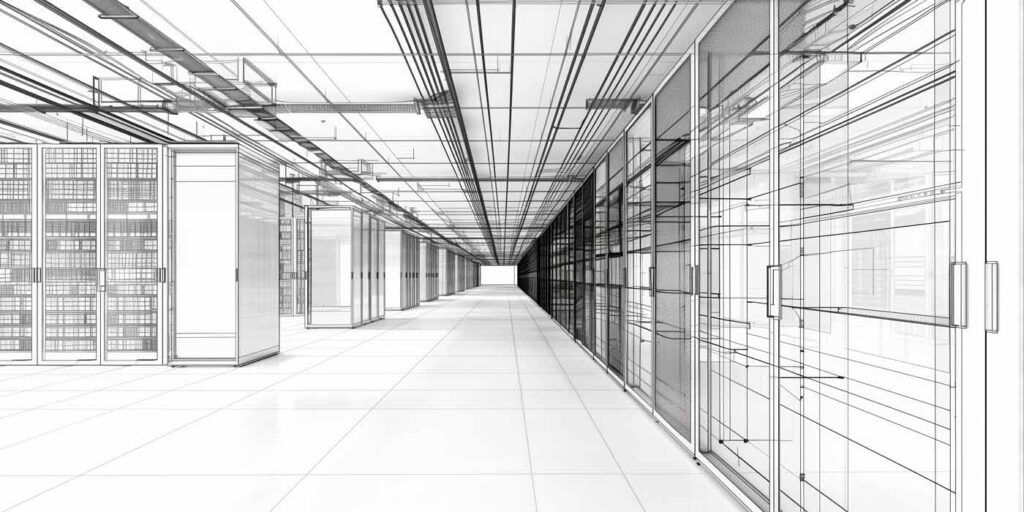We often picture the internet as a cloud, but its lifeblood runs through physical infrastructure. That infrastructure is housed in high-tech facilities known as data centers. From small regional servers to hyperscale cloud campuses, these are the backbone of modern life, powering everything from hospital systems and banking transactions to grocery logistics and smart homes. And like any critical industrial environment, server farms face real threats – chief among them: fire.
A single fire incident at a computing facility can lead to devastating downtime, averaging 17.5 hours plus IT reboot time, resulting in significant data loss and millions of dollars in subsequent damage. And for facilities that never sleep, the margin for error is razor thin. Keeping these operations secure requires an advanced, highly responsive approach to industrial fire protection.
A unique challenge
Unlike traditional commercial spaces or even manufacturing facilities, technology hubs present a complex fire risk profile. These environments are packed with high-voltage electrical equipment, rapidly circulating air systems, and densely configured hardware racks – all of which can accelerate the spread of smoke or heat. Add to that the sensitivity of the equipment itself, and it’s clear that standard solutions won’t cut it.
That’s why specialized fire safety frameworks for warehouses and data centers must be carefully designed, installed, and maintained by experts with deep knowledge of both fire codes and the technological nuances of the space.
It starts with design
Effective fire protection begins long before the first server is installed. In the design phase, facilities must plan for code compliance and business continuity. This includes selecting the right type of fire suppression infrastructure – often a clean agent system or a pre-action fire sprinkler.
Clean agent systems use gas-based suppression methods that leave no residue and are safe for sensitive equipment, making them ideal for safeguarding data servers and electrical infrastructure. They extinguish fires quickly while minimizing downtime and damage, preserving both assets and operations.
Pre-action fire sprinkler systems offer a key advantage in server farms, as they only activate after two conditions are met. First, heat or smoke must be detected; then, it must receive a signal confirming the fire. This two-step process adds a layer of safety and shields vital equipment from unnecessary damage.
Compliance isn’t optional
The National Fire Protection Association (NFPA) sets stringent guidelines to ensure life and property safety. For computing facilities, staying up to date with NFPA compliance is a business necessity.
NFPA 75 and NFPA 76, which govern the protection of information technology equipment and telecommunications facilities, respectively, lay out detailed requirements for detection, suppression, and emergency power. A certified fire protection contractor in the Mid-South can help your facility meet these standards at every stage of development and operations.
Inspection and maintenance: A hidden shield
Too often, fire safety frameworks are treated as “set-it-and-forget-it” infrastructure. But in high-value, always-on environments like data centers, regular fire inspection services are essential. A minor fault, such as an obstructed sprinkler head or a faulty sensor, could lead to failure when it matters most.
Scheduled maintenance and performance testing of fire alarms, suppression systems, and detection technology provide peace of mind that everything will work exactly as designed. Additionally, regular audits support insurance requirements and keep facilities compliant with both local fire codes and NFPA standards.
Risk assessment: An ongoing process
technology hubs evolve fast. As new racks are installed, cooling systems upgraded, or server configurations shifted, the original plan may no longer provide adequate coverage. That’s why a comprehensive industrial fire risk assessment should be conducted routinely. These assessments look at airflow, heat mapping, electrical load distribution, equipment placement, and escape routes to determine how risk is distributed and how infrastructure needs to adapt – ensuring that evolving systems remain compliant and safeguarded.
Building for the future
Fire safety in server farms is about avoiding catastrophe, yes; but it’s also about enabling uptime, shielding investments, and reinforcing trust. The ripple effects of a fire in one facility can reach millions of people within minutes. And as demand for data storage and processing capacity continues to surge, fire defense must scale in tandem.
Manufacturers of fire protection technology are responding with intelligent detection frameworks and networked alarms that communicate in real time. Forward-thinking organizations are embracing this innovation, but adoption alone isn’t enough. It’s vital that these setups be installed and maintained by professionals who understand the intersection of manufacturing fire safety, high-tech infrastructure, and regulatory obligations.
In a time where everything depends on digital connectivity, safeguarding data centers isn’t just a technical task – it’s our responsibility.

